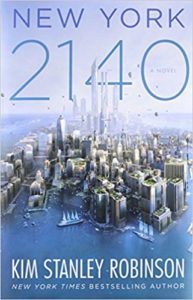Cat Rambo's Blog, page 26
January 3, 2019
Progress Report: What’s Up For the Rambo Academy in 2019
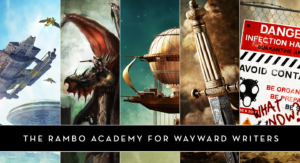 I started my little online writing school, the Rambo Academy for Wayward Writers, with the launch of Google Hangouts, which enabled me to host classes for people across the globe. Since then, Hangouts has declined, but the school continues strong, having hosted hundreds of students from around the world. Over a dozen of the best writers and teachers in the fantasy and science fiction field — with several new folks joining us in early 2019 — have led workshops on over three dozen topics.
I started my little online writing school, the Rambo Academy for Wayward Writers, with the launch of Google Hangouts, which enabled me to host classes for people across the globe. Since then, Hangouts has declined, but the school continues strong, having hosted hundreds of students from around the world. Over a dozen of the best writers and teachers in the fantasy and science fiction field — with several new folks joining us in early 2019 — have led workshops on over three dozen topics.
Perhaps the most rewarding thing about the school has been the network of friends it’s helped me build, with students joining on to score Nebula and Hugo awards and multiple publications, many moving into the F&SF world as editors and publishers as well. Another is that I get to sit in on classes by some amazing folks, which enriches my writing.
Looking back at my own bibliography, I have to laugh at how many flash or shorter pieces started as writing exercises for the classes that I did along with the students. And one of the things that amuses me most about the school is that it is partially responsible for Rachel Swirsky’s lovely, luminous, and somewhat notorious “If You Were a Dinosaur, My Love,” which she wrote when sitting in on the Literary Techniques for Genre Writers class.
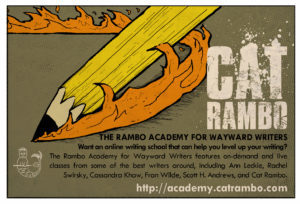
Image by Keith Rosson. www.keithrosson.com
It’s spawned two books, both Moving from Idea to Finished Draft and Creating an Online Presence for Writers, currently being updated for 2019 and the ever-changing social media landscape. And while it started with live classes, it’s added on-demand offerings as well. I’ve made it part of my Patreon campaign.When I started recruiting other writers to teach, I kept in mind the reason I had started teaching online in the first place — irritation with a local college, where I was teaching a six week workshop, and making $25 an hour there teaching a class whose participants were paying several hundred dollars to the college to take it. The philosophy of the Academy is that the bulk of the money should go to the teacher and that’s worked well, to the point where one teacher said recently that teaching for me had spoiled them for teaching unpaid convention workshops.
Another part of the school’s philosophy is paying things forward and making the class accessible to people who couldn’t otherwise afford by providing three free slots in each class (sometimes more). These are the Plunkett scholarships, named for the fantasy writer Lord Dunsany, aka Edward Plunkett. Teachers are paid for Plunkett students, and are not told who in the class has received one.
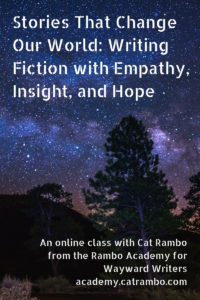 Nowadays I actively go out and recruit some instructors, looking for workshops that aren’t being given, deep dives into a specific area rather than a broad overview. Some great examples are Build a Better Monster with SCIENCE with Seanan McGuire or Ann Leckie’s To Space Opera and Beyond as well as some of my own workshops, like Punk U, which covers all the -punk variants like steampunk, cyberpunk, hopepunk, solarpunk, monkpunk, and more, or Stories That Change the World: Writing Fiction with Empathy, Hope, and Insight.
Nowadays I actively go out and recruit some instructors, looking for workshops that aren’t being given, deep dives into a specific area rather than a broad overview. Some great examples are Build a Better Monster with SCIENCE with Seanan McGuire or Ann Leckie’s To Space Opera and Beyond as well as some of my own workshops, like Punk U, which covers all the -punk variants like steampunk, cyberpunk, hopepunk, solarpunk, monkpunk, and more, or Stories That Change the World: Writing Fiction with Empathy, Hope, and Insight.
So what’s coming up in 2019 for the Academy?
New live classes! People asked for a class on plotting novels, and I have set up one taught by Kay Kenyon, who I’ve co-taught with multiple times and is an engaging and talented teacher. I also just confirmed that Catherine Lundoff will be teaching live workshops In Flagrante Delicto: Writing Effective Sex Scenes and So You Want to Write an Anthology?
Other topics I’m talking with people about are workshops on writing superhero fiction, politics and worldbuilding in SF, and writing when short of time.
More on-demand classes! I’m currently working on an on-demand version of the Flash Fiction workshop and after that will do the Punk U class. Also working on turning the Sutter class into an on-demand version. I’ve developed a more consistent format that I’m happy with, a mix of video, text, and writing exercises.
Transcripts for the video components and (possibly) subtitles. This is a big accessibility issue that has been bugging me for a while and I apologize for not having addressed it before.
More activity on the school blog, including guest posts and interviews with faculty.
We have to move away from Google Hangouts! Currently I’m exploring options and am probably going to go with Zoom.
More use of the Youtube channel.
Rambo Academy merch, because who doesn’t want a Rambo Academy for Wayward Writers hoodie?
2018 was a banner year for the school, in which it grew by leaps and bounds. I hope for the same in 2019, and invite you to join me on its journey!
#sfwapro
December 31, 2018
2018 in Retrospect Plus Here Comes 2019: Ever Onward, Ever Hopeful, Ever Joyful
 There’s only one day left of this year in which to reflect upon it, and one thing I’ve been urging students to do is sit down and reckon up some of their accomplishments as well as planning out next year’s goals. So here I am, practicing what I preach.
There’s only one day left of this year in which to reflect upon it, and one thing I’ve been urging students to do is sit down and reckon up some of their accomplishments as well as planning out next year’s goals. So here I am, practicing what I preach.
Fiction-wise, the biggest thing published was my fantasy novel, Hearts of Tabat, in May. (If you’re one of the folks who enjoyed it, please think about putting up a review on Amazon, GoodReads, or wherever.) While it’s book two of the Tabat Quartet, it functions as an introduction to the series as well as the first book, Beasts of Tabat, does, and maybe they actually read better in that order, I dunno.
Other publications included stories for my Patreon campaign, this dour little piece of flash in Daily Science Fiction, and stories in anthologies, including “My Name is Scrooge” in The War on Christmas.
I finished up writing two novels, one of which (You Sexy Thing, a space military fantasy) is off with my agent, another (The Five of Us, a MG far future space story) of which I’m currently editing, and got halfway through two others: Exiles of Tabat (the sequel to Hearts of Tabat) and Devil’s Gun (sequel to YST).
The anthology I edited, If This Goes On from Parvus Press, will come out in spring of 2019, and is chockfull of good stuff. So will the little collection that’s intended as a reward for Kickstarter backers, Rambo on Rambo. Thank you to Parvus as well as my rocking team of slush readers, who heroically tackled (literally) hundreds of stories.
The Patreon effort continued to grow, and I hope in 2019 to get it to the point where I can start my own monthly magazine. One helpful thing I started doing was using the software Airtable, which came recommended by Pablo Defendi, and treating the effort as though it were itself that magazine, with weekly features like Tasty Thursdays, in which I provide and talk about a recipe, and Friday Questions, a mini Ask-Me-Anything where conversations can range all over the place. I also hooked in my Discord server for $5 and up patrons and coaching clients and also recruited some other writers and Rambo Academy faculty in order to create a community where people could encourage and motivate each other as well as trade story and novel critiques,
Nonfiction-wise, I finished up the book for Moving from Idea to Finished Draft. I wrote a couple of Clarkesworld essays, “The Future, Ordinary” and “Saving throw vs. Boredom: How RPGs Taught Me Storytelling“. I also published a new class, Hex-Engines and Spell-Slingers: Writing Steampunk and Weird Western. I did a number of reviews for Green Man Review, and have several more in the pipeline – just need to get back into the groove of doing those. I wrote the usual round of blog posts, including favorites On Writing: Advice for Attending a Writing Workshop, Chekhov’s Gun Store, and When and Why to Hire an Editor, And What They Should (and Shouldn’t) Do
The Rambo Academy for Wayward Writers overall gained a few more teachers, and continues to grow, which is frickin’ awesome, and lets me sit in on classes by the likes of Ann Leckie, Seanan McGuire and Rachel Swirsky, along with a host of other great folks. We had our first gamewriting-related class, High-Speed Worldbuilding for Fiction and Games with James L. Sutter. Check out the latest version of the faculty list. Speaking of teaching, over a thousand students have come through the Rambo Academy now, which is awesome, and I added several new live classes to the roster. I expanded the number of free slots in each class from one to three.
I went to the usual round of conventions, including International Conference for the Fantastic in the Arts, Norwescon, Emerald City Comic Con, GenCon, WorldCon, DragonCon, GirlGeekCon, Surrey International Writers Conference, and Pacific Northwest Writers Association. I got to both tell Peter S. Beagle he was the new SFWA Grand Master and then give him the award — and I get to do the same with another personal hero this coming May. I was a mystery muse for Clarion West this summer and some of the students from there took me up on my offer of a coaching call (If you’re one of them reading this and sad you didn’t, the offer is still open.)
I made my Twitch TV debut as part of the crew playing Esper Genesis. One ball I’ve dropped is getting SFWA set up with a Twitch effort, but that requires figuring out what form that might manifest in as well as assembling the right volunteer team to care for it. My name is in the rulebook as a playtester, which makes me proud and happy.
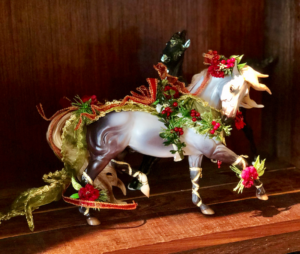 SFWA continued and continues to make strides forward into the 21st century, despite various small contretemps along the way, and I expect it to break the 2,000 member mark in 2019. Things that got implemented or that kept surging along in 2018, in no particular order:
SFWA continued and continues to make strides forward into the 21st century, despite various small contretemps along the way, and I expect it to break the 2,000 member mark in 2019. Things that got implemented or that kept surging along in 2018, in no particular order:
I’ve been working on prodding the SFWA Youtube channel into existence since I was Vice President, and this year it really started to find its feet under the adept leadership of Diane Morrison. Some highlights include. Please check it out and subscribe – lots of good stuff is in the pipeline including gamechats with Jason Stevan Hill and James L. Sutter.
The mentorship program was launched. That’s been a long and painful struggle because we wanted to make sure we got it right, but the first wave of mentors and mentees got matched and the results (and numbers) are terrific. I’m mentoring someone myself — if you’re interested in participating in one or the other (or both) sides of that the next time they open up to matches, keep an eye on the website.
The Givers Fund created by outgoing SFWA CFO Bud Sparhawk continues to roll along disbursing money to efforts promoting fantasy and science fiction. Much of the money raised for this comes from our partnerships with HumbleBundle and Storybundle, which we have worked with in the last 2 years to create Nebula-themed offerings as well as efforts throughout the year, including two SFWA-author Storybundles.
The first Nebula Awards weekend I ever went to was a hotel banquet plus a handful of desultory panels. Nowadays it’s a bajillion times busier, bigger, and full of requested features. At some point it deserves a blog post all its own. In 2019 (and 2020), it’s in Woodland Hills, California.
The Partners and Spouses party at the Nebulas was another thing I’ve pushed for, an event honoring the folks who often make it possible for writers to write, hosted by the inimitable (and SFWA Ombudsman) Gay Haldeman. In 2018 there was even programming aimed at those folks, assisted by Michelle Appel.
Indie members have been one of my foci all along and I continue to see them shaping the organization with their enthusiastic, energetic, and above all market-savvy input. We continue to be the only org of this kind letting people qualify with crowd-funded projects. Efforts associated with them include the NetGalley program and the New Release Newsletter.
Finally that frickin’ Game Nebula plus revised membership requirements for game writers are in place. Check out the SFWA Recommended Reading list to see some of the games SFWA members are playing and recommending.
The continued growth of the SFWA volunteer program under Derek Kunsken’s adept hand continues to please, and the volunteer breakfast that we implemented three years has (I hope) become a mainstay, along with the cool thank you certificates handed out there.
Kate Baker helped organize Six Sigma training for the Board at the Nebulas this year and the extra day of that was so well worth it that we’ll be doing it again in 2019.
SFWA Ed is rocking along under Jonathan Brazee’s able hand, they’ve got several claases up already, and I’m working on a mini-project for them right now.
Publications are getting sorted out. The Bulletin continues to lurch towards a more regular production schedule and has some things it previously lacked, like submission guidelines. The Singularity, originally intended to solve the problem of people getting a piece of mail from SFWA, going “I don’t want this,” and unsubscribing not realizing that meant no more e-mails from SFWA at all, including stuff about the Nebulas and the SFWA elections, has a regular schedule and is always full of great stuff, with people using it, which is a nice sign. Moving the Forum (and once and for all ending the confusion between its name and the electronic discussion forums) to electronic form only and re-shaping it into the Binary, a twice-yearly members-only formal writer-up of votes, committee and board member reports, and budget numbers, has been another effort that has been successful and helped turn soemthign a little retro looking into an entity for this century.
Social media is getting more of a focus lately, and I see the SFWA Twitter account bubbling up all sorts of good content from past years on the SFWA blog, including a number of my own pieces.
Another of my visions, the SFWA First Chapters project, designed to help with the perennial question, how do I sift through the kerjillion novels that come out in a single year, is off and running!
Undoubtedly I have forgotten a kerjillion things that I will remember right after posting this; I will edit them in as they occur to me.
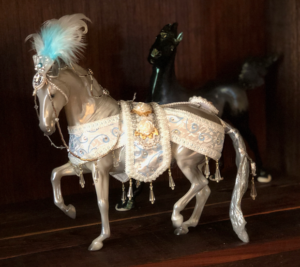 Some SFWA moments, like writing up a requested statement on what a SFWA President does for the Elections committee, are a little bittersweet because it’s the last year of my Presidency. While I am REALLY looking forward to putting more time and mental bandwidth into writing, I know I will miss a great many of the interactions. I will continue to work with the org as a volunteer — that sorta goes without saying, I think, but I’m still figuring out what I want to do. I got to make my final round of picks for the next SFWA Grandmaster, the recipients of the Kate Wilhelm Solstice Award, and the Kevin O’Donnell Jr. Service Awards, and they’ve all been Board-approved and notified, and I am super happy with the chance to acknowledge them all. This will be my last Nebulas as SFWA President, the closest I’ve gotten to playing prom queen in this life, and so I’m trying to figure out how I’m going to out-do last year’s banquet dress.
Some SFWA moments, like writing up a requested statement on what a SFWA President does for the Elections committee, are a little bittersweet because it’s the last year of my Presidency. While I am REALLY looking forward to putting more time and mental bandwidth into writing, I know I will miss a great many of the interactions. I will continue to work with the org as a volunteer — that sorta goes without saying, I think, but I’m still figuring out what I want to do. I got to make my final round of picks for the next SFWA Grandmaster, the recipients of the Kate Wilhelm Solstice Award, and the Kevin O’Donnell Jr. Service Awards, and they’ve all been Board-approved and notified, and I am super happy with the chance to acknowledge them all. This will be my last Nebulas as SFWA President, the closest I’ve gotten to playing prom queen in this life, and so I’m trying to figure out how I’m going to out-do last year’s banquet dress.
 A nice highlight, coming in late fall, was that I got a helper! The daughter of a friend, Molly Louise, has been working hard at putting together a more regular social media presence, doing some writing for the blog like To France and Beyond and What Happened to Sabrina?, helping put together the newsletter, and creating some fun graphics. It’s been a big help and I look forward to working with her in the New Year.
A nice highlight, coming in late fall, was that I got a helper! The daughter of a friend, Molly Louise, has been working hard at putting together a more regular social media presence, doing some writing for the blog like To France and Beyond and What Happened to Sabrina?, helping put together the newsletter, and creating some fun graphics. It’s been a big help and I look forward to working with her in the New Year.
Sadder notes of 2018 included losses like Ursula K. LeGuin, Mary Rosenblum, and my friend K.C. Ball. I was touched that Orycon asked to reprint my tribute to her in its program.
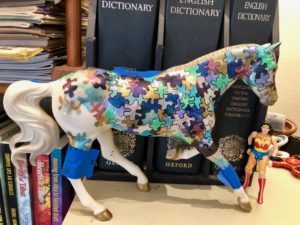
I had bought a lot of 4 horses for the sake of the Stardust Unicorn in it, and decided to modify one of the excess ones.This is still in progress.
The pictures illustrating this write-up show a new obsession: Breyer horses. Throw in the availability of used toys and memorabilia on eBay and you have a recipe that sates my inner 12-year-old. Here’s the one I’ve been working on customizing. It’s a fun rabbit-hole, and my BFF and I are planning a trip to Breyerfest in the middle of the year.I’m looking forward that as well as to a lot of projects in 2019. A lot of last year’s productivity was spurred by finding a new writing process last September, one which is painful yet productive, and which involves getting up at 5:30, hitting the gym, and then denying myself Internet until I’ve hit my wordcount mark. It’s based on Chris Fox’s 5,000 Words an Hour.
What I am looking forward to in 2019:
Turn in Exiles of Tabat, the MG novel, and the next few books in the space series, which is planned on as a somewhat insane ten book story arc.
On-demand versions of the flash fiction class, the all the -punks class, and the Stories that Change the World class.
Finally get the third edition of Creating an Online Presence done.
Frequent visitors will have noticed more guest blog posts on here. I’m hoping that eventually I can grow it into a monthly magazine of sorts since the Patreon continues to gain traction. If you’ve got something you’re promoting that you want to guest blog about or are interested in talking about some sort of semi-regular column, please drop me a line. By the end of 2019, I hope to have made significant progress towards that goal.
Moving the Chez Rambo household to a new place – we’re looking for new digs, probably still here in West Seattle, and I know that’s going to be a major effort.
Upcoming/planned appearances include Confusion in January, Norwescon, the Nebulas, GenCon, WorldCon (Dublin!), Cascade Writers, PNWA and Surrey International Writers Conference. I’ve also booked a treat for myself in the form of a trip to Breyerfest with my best friend in July, which should be a hoot and a half. Neither of us have ever been and I’m working on booking us an Airbnb that will let us interact with live horses too. If you have suggestions of things we should see while in the Lexington area, let me know!
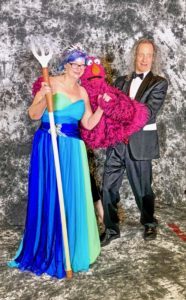 Resolutions aren’t usually something I formally do, but I am going to try to be better about keeping up with my journal/notebook this year, because I find recording things like word counts for writing sprints or tallying gym visits makes me more mindful of and better about doing them. I like to jot down “10 Things About Today” in my daybook on a regular basis because I like looking back at those small details and remembering incidents, like seeing two little girls in purple ballerina skirts purposefully making their way up a hill yesterday or talking to a woman in the gym about the book she’s reading. I’d like to pick up the habit of meditation, because my mind is a monkey-mind, constantly distracted, worrying, and busy puzzling things out and composing pretty phrases in my head.
Resolutions aren’t usually something I formally do, but I am going to try to be better about keeping up with my journal/notebook this year, because I find recording things like word counts for writing sprints or tallying gym visits makes me more mindful of and better about doing them. I like to jot down “10 Things About Today” in my daybook on a regular basis because I like looking back at those small details and remembering incidents, like seeing two little girls in purple ballerina skirts purposefully making their way up a hill yesterday or talking to a woman in the gym about the book she’s reading. I’d like to pick up the habit of meditation, because my mind is a monkey-mind, constantly distracted, worrying, and busy puzzling things out and composing pretty phrases in my head.
I hope to be better about both maintaining existing ties as well as establishing new ones, much of that in the form of letting my amazing friends and family know how much I appreciate them. To be a little more tidy in my daily existence for the sake of my own sanity, since an orderly environment is so much nicer than living on the edge of creeping chaos. And finally, to make more art for the sake of making art, like my notebook doodles or the masks I make every once in a while or my little Breyer customization project.
To continue to work on thinking before speaking, to encouraging other voices to talk — and listening to them, and to be mindful of the impact of my words. To continue to work at being able to go to bed knowing I’ve worked to make some good things happen in the world, that I’ve cultivated love rather than spread hate, and that, above all, that I’ve been true to myself.
Here’s to a shiny 2019 for us all.
Peace out,
Cat
#sfwapro
December 24, 2018
Rambo Academy Sale Through December 31
Happy end of the year to all of you!
UPDATE: This went so well and everyone was so grateful that I went ahead and extended the sale through the end of the year. There are new links below to coupons that should let you access the classes at the $5 price. Let me know if there are any issues!
We are wrapping up the end of the year with a special promotion for THREE DAYS ONLY, December 24-26, by offering all Rambo Academy for Wayward Writers on-demand classes, including the ones from Ann Leckie, Rachel Swirsky, and Juliette Wade, for $5 or less.
Yep, that’s right. For less than $50 you can, in fact, buy access to every class we currently offer. Did I mention it’s only through midnight of the 26th, aka three days (well, a little more since this is going out Sunday evening) only?
This is a let’s-close-out-2018-with-a-bang promotion and won’t be repeated again until next December (if we do). Here insert me talking in a Thunderdome announcer’s voice and repeating that vital phrase, THREE DAYS ONLY.
Seriously, though. If you want to pick up one (or many) of the classes, now’s the time, and you have lifetime (well, Teachable’s lifetime, which may or may not match mine or yours) access. And pass this offer along to as many people as you like, particularly your writing groups and friends. The more the merrier.
Want a live class? There’s still a few slots open in Stories That Change Our World as well as all the other live January classes, including opportunities with Seanan McGuire, Rachel Swirsky, and Fran Wilde.
And look for plenty of new Rambo Academy material there in the coming year, including on-demand versions of the Flash Fiction workshop, Punk U: How to Write -punk Fiction, Rachel Swirsky’s Speculative Poetry class, James Sutter’s High-Speed Worldbuilding, a class from Diane Morrison on time management and writing in odd moments — and more.
Click on the links to access the sale coupons:
Character Building Workshop for $5
Description and Delivering Information for Genre Writers for $5
Hex Engines & Spell-Slingers: Write Steampunk/Weird Western for $5
Literary Techniques for Genre Writers for $5
Moving from Idea to Finished Draft for $5
Old Stories Into New with Rachel Swirsky for $5
The Power of Words with Juliette Wade for $5
Reading to an Audience Workshop for $3
Rewriting, Revising, and Fine-Tuning Your Fiction for $5
To Space Opera and Beyond with Ann Leckie for $5
Recent Stuff from the Blog and Patreon
I’m continuing to update the listing of awards posts from F&SF publishing people every few days. Let me know if yours should be on there.I talked about the process behind the development of one of my favorite stories, “Rappacini’s Crow.”
I tried to consolidate a lot of useful resources for F&SF writers into this page, and am working on one for online writing workshops next. Suggestions for items to include on either page are welcome.
J.D. Moyer on Writer’s Workshops with Kim Stanley Robinson
Bitterballen – Carleton Chinner Presents The Tastiest Snack You’ve Never Heard Of
Jennifer Lee Rossman talks about her new novel, Jack Jetstark’s Intergalactic Freakshow
Edward M. Erdelac talks about his novel The Knight With Two Swords and The Women of Arthurian Lore
Interested in doing a guest blog post? The guidelines are newly updated to include more possibilities.
This month I featured a charity for holiday giving each day on my Patreon page. You can find them all here, regardless of whether or not you’re a Patreon supporter. Other things supporters got included a Q&A with Taco, photos of the current craft project, recipes, writing tips and resources, market news, snippets, and access to the Chez Rambo Discord server. Check out the Patreon page to find out how you can join our community!
The December giveaway is a novel critique by Cat. Mail me at cat AT kittywumpus.net by midnight December 31 with the subject line “December 2018 Giveaway.”
Three Day Rambo Academy Sale
Happy end of the year to all of you!
We are wrapping up the end of the year with a special promotion for THREE DAYS ONLY, December 24-26, by offering all Rambo Academy for Wayward Writers on-demand classes, including the ones from Ann Leckie, Rachel Swirsky, and Juliette Wade, for $5 or less.
Yep, that’s right. For less than $50 you can, in fact, buy access to every class we currently offer. Did I mention it’s only through the 27th, aka three days (well, a little more since this is going out Sunday evening) only?
This is a let’s-close-out-2018-with-a-bang promotion and won’t be repeated again until next December (if we do). Here insert me talking in a Thunderdome announcer’s voice and repeating that vital phrase, THREE DAYS ONLY.
Seriously, though. If you want to pick up one (or many) of the classes, now’s the time, and you have lifetime (well, Teachable’s lifetime, which may or may not match mine or yours) access. And pass this offer along to as many people as you like, particularly your writing groups and friends. The more the merrier.
Want a live class? There’s still a few slots open in Stories That Change Our World as well as all the other live January classes, including opportunities with Seanan McGuire, Rachel Swirsky, and Fran Wilde.
And look for plenty of new Rambo Academy material there in the coming year, including on-demand versions of the Flash Fiction workshop, Punk U: How to Write -punk Fiction, Rachel Swirsky’s Speculative Poetry class, James Sutter’s High-Speed Worldbuilding, a class from Diane Morrison on time management and writing in odd moments — and more.
Click on the links to access the sale coupons:
Character Building Workshop for $5
Description and Delivering Information for Genre Writers for $5
Hex Engines & Spell-Slingers: Write Steampunk/Weird Western for $5
Literary Techniques for Genre Writers for $5
Moving from Idea to Finished Draft for $5
Old Stories Into New with Rachel Swirsky for $5
The Power of Words with Juliette Wade for $5
Reading to an Audience Workshop for $3
Rewriting, Revising, and Fine-Tuning Your Fiction for $5
To Space Opera and Beyond with Ann Leckie for $5
Recent Stuff from the Blog and Patreon
I’m continuing to update the listing of awards posts from F&SF publishing people every few days. Let me know if yours should be on there.I talked about the process behind the development of one of my favorite stories, “Rappacini’s Crow.”
I tried to consolidate a lot of useful resources for F&SF writers into this page, and am working on one for online writing workshops next. Suggestions for items to include on either page are welcome.
J.D. Moyer on Writer’s Workshops with Kim Stanley Robinson
Bitterballen – Carleton Chinner Presents The Tastiest Snack You’ve Never Heard Of
Jennifer Lee Rossman talks about her new novel, Jack Jetstark’s Intergalactic Freakshow
Edward M. Erdelac talks about his novel The Knight With Two Swords and The Women of Arthurian Lore
Interested in doing a guest blog post? The guidelines are newly updated to include more possibilities.
This month I featured a charity for holiday giving each day on my Patreon page. You can find them all here, regardless of whether or not you’re a Patreon supporter. Other things supporters got included a Q&A with Taco, photos of the current craft project, recipes, writing tips and resources, market news, snippets, and access to the Chez Rambo Discord server. Check out the Patreon page to find out how you can join our community!
December 21, 2018
Guest Post: The Knight With Two Swords and The Women of Arthurian Lore
 My love of Arthurian lore definitely began with a trio of books my aunt lent me as a kid, Mary Stewart’s Merlin Trilogy, The Crystal Cave, The Hollow Hills, and The Last Enchantment. I knew only a little about King Arthur and Merlin and the rest, and the allusions to historical Roman Britain and the grounding of Merlin’s vaunted magic in science was revelatory to me at the time, though I admit I didn’t wind up pursuing the path of historicity myself, instead cleaving to the fairy story aspects. My Arthur isn’t the much-debated 6th century British chieftain, but the boy who drew a sword from a stone. My Merlin is all seeing, all knowing, and can appear in any forest by passing through the hedgerows planted by Queen Gloriana in the Garden of Joy.
My love of Arthurian lore definitely began with a trio of books my aunt lent me as a kid, Mary Stewart’s Merlin Trilogy, The Crystal Cave, The Hollow Hills, and The Last Enchantment. I knew only a little about King Arthur and Merlin and the rest, and the allusions to historical Roman Britain and the grounding of Merlin’s vaunted magic in science was revelatory to me at the time, though I admit I didn’t wind up pursuing the path of historicity myself, instead cleaving to the fairy story aspects. My Arthur isn’t the much-debated 6th century British chieftain, but the boy who drew a sword from a stone. My Merlin is all seeing, all knowing, and can appear in any forest by passing through the hedgerows planted by Queen Gloriana in the Garden of Joy.
Nevertheless, Stewart led me to John Boorman’s Excalibur, which led me to Sir Thomas Mallory and T.H. White. Years later a woman I worked with lent me The Mists of Avalon, and it was the clash between Christianity and paganism there that arrested me. After reading Bradley I rediscovered Mary Stewart in the unofficial sequel to the Merlin Trilogy, the Morded-centric standalone novel, The Wicked Day.
All of these ingredients went into the mix of my forthcoming novel The Knight With Two Swords, a retelling and expansion of The Tale of Sir Balin related in Le Morte D’Arthur.
The titular Balin is a temperamental, reactionary knight, the greatest of Arthur’s champions prior to the arrival in Camelot of Sir Lancelot. He and his twin brother Brulen are affected early on by the murder of their pagan mother at the hands of Christian fanatics, yet the two brothers come away from the experience with very different outlooks; Balin blames the pagan sisterhood of Avalon for corrupting his mother, whereas Brulen sets himself as an outlaw against all that is Christian.
This makes the court of Camelot, where both the Archbishop Dubricius and Merlin the Enchanter have a hold of King Arthur’s ears, a bewildering place for Balin. He seethes, torn between serving God’s chosen king and striking down what he perceives as the serpents in his shadow.
His personal conflict comes to a head when a mysterious woman girded with an enchanted sword visits the court, and no man but Balin can draw it. Yet, she warns him, though it will make him the greatest knight in the land, it will also doom him to kill the one he loves best….
This woman is Nimue, a familiar face in Arthurian lore. Named as one of the three queens who, along with Morgan Le Fay and The Queen of Norgales (who I’ll talk a little about later) ultimately accompanies the body of Arthur on his funeral barge, she is invariably described throughout the lore as an enchantress, the temptress who traps Merlin in a tree, and The Lady of The Lake herself.
The names of The Lady of The Lake are almost legion. There is Lile (who Phyllis Ann Karr in her Arthurian Companion suggests only became an individual when someone mistranslated the French ‘l’ile d’Avilion’ as ‘Lile of Avalon’), Viviane, Nineve, and Sebill from the Vulgate Cycle, to name a few. As others have done before me, in Knight With Two Swords, they have all held the office of Lady of The Lake, and as the embodiment of Balin’s scorn for Avalon and its pagan mysteries, definitely have an impact on the tragic course of his life.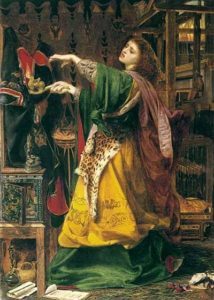
Other, less well known female characters from across Arthurian lore make appearances too, such as the mother of Merlin, Adhan, and his sister Gwendydd, who probably first appeared in Cyfoesi Myrddin a Gwenddydd ei Chwaer, a poem from the Red Book of Hergest attributed to a bard named Myrddin. In the old story, Gwendyyd’s son is killed in battle by her brother, and Myrddin goes mad when she disavows him. Geoffrey of Monmouth calls her Ganieda in his later Vita Merlini, where she cuckolds her husband Rhydderch Hael, and Myrddin tells on her. Geoffrey Latinized Myrddin into Merlin, possibly replacing the ‘d’ with an ’i’ because ‘Merdin’ sounded too close to ‘Merde’ (‘shit’ in French). In The Knight With Two Swords, Gwendydd is the bridge between Nimue and Merlin, who will tutor her in the magic arts she employs to direct Balin as a weapon of her own personal quest for vengeance.
In the course of Balin’s adventures, he encounters the Aspetta Ventura or, ‘Expected Fortune,’ a castle mentioned in the 14th century Italian take on Tristan, La Tavola Ritonda. The mysterious chatelaine of the castle is Lady Verdoana, known as The Leprous Lady, a woman covered head to toe who demands every maiden who visits her submit to a bizarre bleeding ritual. Cursed by a spurned sorcerer, she can only be cured by the blood of a royal virgin. Needless to say, this leads to shenanigans when Balin and his traveling companions find themselves houseguests.
For the ultimate antagonist of The Knight With Two Swords, I looked to the aforementioned Queen of Norgales. Like The King With A Hundred Knights, she goes unnamed in most stories, popping up now and again in Malory and the French Vulgate Cycle tormenting Lancelot and plotting with Morgan. She is described as one of the three most powerful sorceresses of Britian, behind Morgan Le Fay and The Lady of the Lake. In The Knight With Two Swords, she is a mysterious elderly dowager, always veiled, content to direct the actions of her armies and agents from afar. The widow of a wicked king named Agrippe who invaded the Grail Kingdom at the behest of the Devil, she plays a long game of wits with Merlin himself, whom she considers her grandson, as it was she who set the demon that begat him upon his mother Adhan in a failed attempt to bring forth the antichrist.
The Knight With Two Swords is available in print December 21st, and drops on Kindle on the 26th.
Edward M. Erdelac is the author of twelve novels including Andersonville and The Merkabah Rider series. His fiction has appeared in dozens of anthologies and periodicals including the Stoker award winning After Death and Star Wars Insider Magazine. Born in Indiana, educated in Chicago, he lives in the Los Angeles area with his wife, three kids, and three cats. News and excerpt from his works can be found at:
http://www.emerdelac.wordpress.com
https://www.facebook.com/Edward-M-Erdelac-112183918691
https://twitter.com/EdwardMErdelac
Enjoy this writing advice and want more content like it? Check out the classes Cat gives via the Rambo Academy for Wayward Writers, which offers both on-demand and live online writing classes for fantasy and science fiction writers from Cat and other authors, including Ann Leckie, Seanan McGuire, Fran Wilde and other talents! All classes include three free slots.
If you’re an author or other fantasy and science fiction creative, and want to do a guest blog post, please check out the guest blog post guidelines.
December 16, 2018
Guest Post: Jack Jetstark’s Intergalactic Freakshow
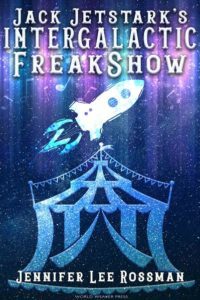 Jack Jetstark’s Intergalactic Freakshow is about the people who don’t fit in. The freaks who are too much like this or not enough like that for society to accept them.
Jack Jetstark’s Intergalactic Freakshow is about the people who don’t fit in. The freaks who are too much like this or not enough like that for society to accept them.
I write from experience. I may not breathe fire or fly or read minds, but I am disabled. And a woman geek. And “too smart for my own good,” according to multiple teachers and psychologists. Somewhere between the first and final draft of this book, though, I realized I have another thing that makes me different.
I’m autistic.
In retrospect, it shouldn’t have been a surprise. I didn’t talk outside the home until I was thirteen, I’ve always hated eye contact, and there may have been a period in my childhood where I communicated primarily through meowing.
But I was disabled and homeschooled and so no one caught it. I was just “weird” or “difficult” or, more often than not, “no seriously, you do not want to screw with her Froot Loops, she just got them sorted by color.” If I’d been diagnosed at an earlier age, maybe I would have felt less weird, less like I was doing something wrong, but it is what it is.
(Technically, I can’t get a formal diagnosis because of accessibility barriers and because the diagnostic process is not designed for disabled adults who were raised as extremely sheltered, antisocial females, but my therapist is confident that I am autistic and I am identifying as such from now on.)
So there I am, 28, newly diagnosed as autistic… oh, and working on the final drafts of my novel. And suddenly some of my editor’s revision notes made so much more sense.
She said some of the characters acted in ways that weren’t true to themselves. I now see that one of these instances (the ending) was the result of me trying to write a really emotional scene and getting frustrated and choosing the logical (to me) solution. Another entire subplot ended up getting rewritten because, in a nutshell, my characters had more complex social lives than I could deal with.
When she asked me to add more descriptions of my characters, such as the clothes they wear or how they interact with objects, I was flummoxed. Beyond gender and race, I didn’t know what they looked like, and nonverbal communication goes right over my head.
I’ve since realized that it’s not uncommon for autistics to have trouble distinguishing facial features. Until I’m a few seasons into a TV show, or I’ve known a person for a few months, I have to rely on context to tell me who they are. (I… may have stopped watching The Expanse the first time Thomas Jane took off his hat, because he was the only character I could recognize.)
These weren’t new problems in my writing, but it’s harder to work around them when writing a novel versus a short story. It’s vital that readers stick with you for two hundred and forty pages.
Figuring out that I’m autistic, letting myself embrace that label, was empowering, both in my writing and in everyday life. I’m not just bad at characterization and socializing, I have a condition that makes those things harder than they should be, and knowing that means I can start trying to find the “cheat codes” for my brain.
People like to know what characters look like, so I’ll ask friends who aren’t faceblind for recommendations of nice-looking people, and I’ll cast them as my characters, and I’ll trust everything my editor says on them making realistic decisions. But I don’t alter my writing too much in the grand scheme.
I would never want to be — or even pretend to be — neurotypical. I’m autistic and weird and my writing is, too.
About the Author:
 Jennifer Lee Rossman is an autistic and disabled sci-fi writer and editor who describes herself as “If Dr. Temperance Brennan was a Disney Princess.” Her work has been featured in several anthologies, and she co-edited Love & Bubbles, a queer anthology of underwater romance. She blogs at jenniferleerossman.blogspot.com and tweets @JenLRossman
Jennifer Lee Rossman is an autistic and disabled sci-fi writer and editor who describes herself as “If Dr. Temperance Brennan was a Disney Princess.” Her work has been featured in several anthologies, and she co-edited Love & Bubbles, a queer anthology of underwater romance. She blogs at jenniferleerossman.blogspot.com and tweets @JenLRossman
Enjoy this writing advice and want more content like it? Check out the classes Cat gives via the Rambo Academy for Wayward Writers, which offers both on-demand and live online writing classes for fantasy and science fiction writers from Cat and other authors, including Ann Leckie, Seanan McGuire, Fran Wilde and other talents! All classes include three free slots.
If you’re an author or other fantasy and science fiction creative, and want to do a guest blog post, please check out the guest blog post guidelines.
December 14, 2018
On Writing Process: A Dissection (of sorts) of “Rappacinni’s Crow”
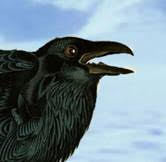
Can a raven be a sociopath?
Someone mentioned this as one of their favorite stories of mine, and I wanted, for selfish and egotistical reasons, to use it for the subject of a blog post, but I hope that I can in pulling it apart and explaining some decisions, shed a little light on both my process and writing in general.If you’re not familiar with the story, it appears here on the excellent online publication Beneath Ceaseless Skies, or you can buy an e-copy on Amazon or Smashwords. If you’re too impatient, here are some of the pertinent details: steampunk world, asylum for those injured by the war, nurse with a secret, doctor with an evil crow, wacky hijinks ensure.
The story takes place in a dystopian steampunk setting that I’d wandered around the edges of previously in “Clockwork Fairies” and “Rare Pears and Greengages”. This story got me far enough into that territory that it spurred others: “Her Windowed Eyes, Her Chambered Heart,” “Snakes on a Train,” and “Laurel Finch, Laurel Finch, Where Do You Wander?” I’ve been calling the series Altered America, and you can see some of the images I’ve used for inspiration here.
And the amount of effort involved in writing the protagonist that appeared to me scared me. Transgendered, Native American, poor, and disabled. How could I write that other without offending someone? Better folks than I have battered themselves against that question. But you can’t do something without trying, so I gave it a shot. I strove to do my best by my protagonist: to explain his background, his history, the way he thought, and his relationship with Jesus. Which is another way my character is unlike me: he is struggling with his Christianity, while I’m Unitarian, a faith that has taught me a great deal, and which I embrace, but which draws on, rather than consists wholly of, Christianity.
I went into that attempt with good intentions, a lot of thought, and some tools provided me by Nisi Shawl and Cynthia Ward’s excellent little book, Writing the Other. I hope I did justice by my protagonist, and I hope he comes back for another story or two, because I want to know what happens to him, over the mountains. I hope it involves him finding his captain — or some reasonable facsimile — again.
As all of this started to take shape in my head, I invoked my favorite Nathaniel Hawthorne story, “Rappacinni’s Daughter,” and made my antagonist part of the Rappacinni line. In doing so, I had to think about how much I was allowing Hawthorne to influence the story. Did I want to try to retell his? Definitely not, because trying to place that structure over what was already in my head was way too square peg, round hole in its feel. So instead I took enough to make it a nod to Hawthorne, an Easter egg for readers who knew what grew in Hawthorne’s fictional garden. The important thing with anything like that is that for readers unfamiliar with the text being referenced, it cannot get in the way of the story or prevent their understanding of it. Make it a plus for readers who’ve read the other text, but never a penalty for those who haven’t.
I injected some of my fascination with Victorian mental institutions, which led to a fascinating time researching. And I put in a crow, because that was where the story came from in the first place, with this question:
In fiction, we generally think of animals as good-souled, noble, and self-sacrificing. What if you had one that wasn’t? That was, in fact, a bit of a psychopath? For the past year I’ve kept peanuts in my pockets and gotten the crows around here to know me, so I was aware of how smart they are, and how much personality they can display. Mine all seem like pleasant souls, but what if there was one that wasn’t?
And thus Jonah fluttered and squawked his way into existence to squat malignantly on Dr. Rappacinni’s shoulder.
Stories are so often collisions of things, a month’s worth of influences and odd thoughts perhaps bouncing off an old obsession or two. With these kinds of stories, for me all I can do is plunge in and start writing, and watch the story start to coalesce. There’s a point where it’s solid enough that I begin to figure out what it’s about, and gradually that emerged in an unexpected shape. It was, I realized, a story about faith, which is not my usual sort of story.
I’m also fond of this story because I used it in teaching, showing students the original story map and how I blocked it out, as well as a couple of early drafts so they could see how things progressed as I was writing it. I didn’t worry too much about length, and it ended up coming in on the low side of novelette length, which limited the markets. Luckily, I knew Scott Andrews at Beneath Ceaseless Skies might well be interested.
Scott, whose comments are always on the mark, had me rework the ending. And having realized what it was a story about helped me reshape that ending into something that satisfied both of us. I wanted it to be a little bit ambiguous in the ending. Was God’s hand evident there or not? You can read it either way, and I like that ambiguity, a quality that fills our existence, in that moment.
Enjoy this writing advice and want more content like it? Check out the classes Cat gives via the Rambo Academy for Wayward Writers, which offers both on-demand and live online writing classes for fantasy and science fiction writers from Cat and other authors, including Ann Leckie, Seanan McGuire, Fran Wilde and other talents! All classes include three free slots.
Prefer to opt for weekly interaction, advice, opportunities to ask questions, and access to the Chez Rambo Discord community and critique group? Check out Cat’s Patreon. Or sample her writing here.
December 12, 2018
Guest Post: Bitterballen – Carleton Chinner Presents The Tastiest Snack You’ve Never Heard Of
 Far further back than I care to admit, the large newspaper I worked for sent me to Amsterdam to attend a trade show. In among the many adventures I had on that trip, I discovered the incredible variety of cuisines that make Amsterdam such a pleasure to visit. The glories of a spread of rijsttafel dishes, gouda cheeses, crisp Dutch beers, and so many others. One of my favourite discoveries was bitterballen the crunchy bar snack with a savory creamy filling that were served alongside beers.
Far further back than I care to admit, the large newspaper I worked for sent me to Amsterdam to attend a trade show. In among the many adventures I had on that trip, I discovered the incredible variety of cuisines that make Amsterdam such a pleasure to visit. The glories of a spread of rijsttafel dishes, gouda cheeses, crisp Dutch beers, and so many others. One of my favourite discoveries was bitterballen the crunchy bar snack with a savory creamy filling that were served alongside beers.
It got me thinking about culture and how food transcends boundaries. Rijstaffel (rice table) is the Dutch version of Indonesian cookery. It dates back to the glory days of the Dutch East India Company, where creaking wooden barques made the perilous journey around the Cape of Storms to venture to the far east colony of Batavia (present day Indonesia). The ships would return laden with exotic spices like nutmeg, mace, and cloves dried and sometimes ground to powder to survive the long journey back to Holland. At a time when the Dutch Republic was entering its golden age, cooks could not get enough of these new flavours and sought out exotic flavours and colours to impress their guest with a dazzling array of dishes.
The sailors also brought recipes back with them, curries, nasi goreng, gado gado sambals,fried bananas and others. Back in Amsterdam people tried to make these recipes, but lacking the fresh ingredients, they substituted dried spices.
While the colonial excesses of the rijsttafel banquets have long since fallen out of favour in Indonesia, they remain a staple of Dutch restaurant fare, as former colonials returned following independence.
What’s in a name? Bitterballen, are part of the larger tradition of bittergarnituur, or savoury snacks to serve with beer. Ballen being the Dutch plural for ball. So, essentially, savoury balls to have with beer.
Bitterballen are one such incarnation of the mixture of cultures permeating Dutch food. The basic recipe was probably taken from a French croquette filled with ragout, a traditional way of using leftover meat. The filling is shredded cooked meat mixed with a thick roux, to which with the addition of nutmeg brings an exotic flavour.
In my latest science fiction novel, Plato Crater, Holly a young thief is sentenced to community service in one of the only antique rijsttafel restaurants still licensed to burn hydrocarbons. One of the first dishes she learns to cook is bitterballen. This is how I imagined the recipe to be:
INGREDIENTS
For the filling:
1 stick of butter
1 cup of flour
2 cups of shredded cooked beef or veal (usually taken from last night’s leftovers)
3 cups beef broth
1 small onion, chopped
¼ cup fresh parsley, chopped
2 Tbsp olive oil
¼ tsp powdered nutmeg
¼ cup finely grated parmesan cheese
For the breading:
All-purpose flour
2 eggs whisked
Breadcrumbs
Vegetable oil for frying
INSTRUCTIONS
In a large pan, sauté the onions in olive oil until translucent.
Add the butter and once melted, add the flour slowly to make a roux.
Gradually add the broth, while stirring continuously to ensure that the roux absorbs the liquid.
Continue stirring until the mixture thickens.
Add meat and parsley. Cook for around two minutes until the mixture resembles a thick gravy. Stir in the salt, pepper, parmesan and nutmeg.
Transfer the filling mixture to a shallow container and refrigerate for 2 hours or until is has a solid consistency.
Take a spoonful of mixture and roll it into a ball the size of a golf ball.
Dredge the bitterballen in the all-purpose flour, then the egg wash and finally roll it the breadcrumbs. This should make around 20 bitterballen.
Place the bitterballen on a shallow tray in the to the freezer for 30 minutes before frying.
Prepare oil for deepfrying, either using a small saucepan or a deep fryer.
Fry the bitterballen, a few at a time, until golden brown, remove and set on a plate covered in paper towels to absorb excess oil.
Now open a crisp Amstel or pale lager, and serve the bitterballen hot, with a side of Dijon or grainy mustard.
About the Author
 CARLETON CHINNER is an Australian born writer who grew up on a remote farm in South Africa, where the trip to the town library was the highlight of his week. He devoured anything science fiction, fantasy and horror. And, when that wasn’t enough, turned to urban legend and traditional tribal histories which combined to provide a heady brew of stories.
CARLETON CHINNER is an Australian born writer who grew up on a remote farm in South Africa, where the trip to the town library was the highlight of his week. He devoured anything science fiction, fantasy and horror. And, when that wasn’t enough, turned to urban legend and traditional tribal histories which combined to provide a heady brew of stories.
He has settled in Australia as an adult but not before turning up unarmed at a gunfight, discovering dead bodies and fighting off sharks while spearfishing. When not writing, he works as a project manager on large corporate programs. Follow him on Twitter @sunfishau
The CITIES OF THE MOON series is Chinner’s debut series, now available as POD and in ebook form from good online stores everywhere. Book 2 Plato Crater is available from 31 October.
Guest Post: J.D. Moyer on Writer’s Workshops with Kim Stanley Robinson
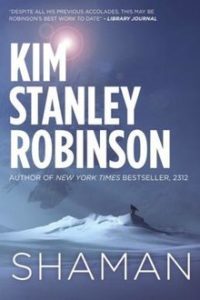 I recently attended a writing workshop with Kim Stanley Robinson via the Locus Writers Workshop series. The workshop was in Oakland, California (where I live), near the Locus offices, and Kim Stanley Robinson is one of my favorite authors. Signing up was a no-brainer.
I recently attended a writing workshop with Kim Stanley Robinson via the Locus Writers Workshop series. The workshop was in Oakland, California (where I live), near the Locus offices, and Kim Stanley Robinson is one of my favorite authors. Signing up was a no-brainer.
Over the course of the day, Kim Stanley Robinson (who goes by Stan) was generous and helpful. His advice was insightful, and sometimes counterintuitive. And there was a lot of it; he’s written for decades and has no shortage of opinions on craft, the writing life, MFA programs, and reviewers. I took copious notes.
Five weeks after the workshop, with time to synthesize, some of that advice stood out. Here are some of the highlights:
Pacing. This was Stan’s biggest focus, in terms of writing craft. He contrasted the breakneck, action-filled Edgar Rice Burroughs Tarzan plots to the glacial but equally gripping pace of Proust’s novels, which include numerous thoughts and impressions. He emphasized that a slower pace, that includes the internal perspectives of the characters, is something that cinema can’t do. He encouraged us to experiment with elastic pacing over the course of a story, speeding up over less interesting bits, and slowing down for pivotal moments.
Prose vs. cinema. Adherence to the “show don’t tell” advice can lead some writers to take on an overly cinematic style, describing only what happens externally, and unnecessarily avoiding both character internality and useful summary/exposition. At the same time, experimenting with a strict “camera eye POV” can be a useful writing exercise.
Plot. Stan suggested we try to maximize both drama and believability. When you have an idea, interrogate the idea – consider how would it really happen. Though not every story needs to be completely realistic – some stories are waking dreams. Never point out or draw attention to the thin ice (low believability). Skate fast over thin ice. (I was surprised by this point because Stan’s work is so obviously well-researched – but ultimately every science fiction writer needs to make some things up)
.
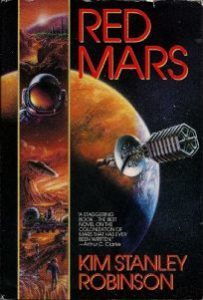 On Career:
On Career:
• With practice and perseverance, you can get published and have some kind of writing career. But there’s no way to force blockbuster success; there’s too much luck involved.
• It’s much better to have no agent than a bad agent. Don’t take on an agent that tries to edit your work. Be cautious and meet a potential agent in person before entering into a contractual agreement.
• On being a full-time writer (vs. having another job): Don’t do the crash and burn thing, don’t write or die. There’s no shame in the part time job. Life needs to be paid for. Don’t starve. He’s seen a lot of people jump off financial cliffs and just crash.
Anecdotes:
• Stan was writing a novel called Green Mars but was worried it would be too long; he was several hundred pages in, and the characters hadn’t yet arrived on Mars. Sharing that concern with his agent, his agent replied “Stan, we call that a trilogy.”
• On Iain Banks: In contrast to Stan’s messy, incomplete first drafts and laborious, multiple subsequent drafts, his friend Iain Banks had a different style. From January through September he would drive to various locations in Scotland and hike the hills, thinking about his next novel and taking a few notes. Then, from October 1st through the end of the year, he would sit down and write a nearly perfect first draft.
Things Stan Dislikes:
• MFA programs. Most writing programs teach three truisms that aren’t consistent — 1) write what you know, 2) find your voice, 3) show don’t tell. Stan’s take is instead to 1) write what you suspect, 2) find your narrator’s voice, and 3) use exposition sensibly.
• The New York literary establishment. Stan admitted he has a big chip on his shoulder in regards to how genre fiction is artificially segregated from literary fiction, and generally looked down upon by the NY literary scene.
• Fantasy. Stan isn’t a big fan of fantasy. To sum up his feelings, he quoted H.G. Wells: “Where anything can happen, nothing is interesting.” Some of us protested that most fantasy is not “anything goes,” but from his point of view, creating a system of rules for magic becomes pseudoscience, or the bureaucratization of magic.
General Advice:
• Read and write poetry, even if you’re bad at it. It exercises a different part of the writing brain (than prose).
• Keep a list of every book you read. When asked why, Stan said “I don’t know!” But on further reflection, he finds it to be a valuable practice for knowing where your head was at during a particular time, what influenced you.
• Don’t be a writing prima donna, demanding special conditions for your writing to occur. Fit your daily writing in, despite the daily pressures of life. Have a writing routine, but also be flexible and adaptable. Make it work.
There was much more than this. Someone else who attended the workshop might have an entirely different set of impressions. I should also point out that I may have gotten some things wrong, that what I remembered or wrote in my notes might not have been what Stan intended to convey. But I think I got the gist of most of it. And I found the workshop as a whole to be incredibly valuable and encouraging.
If you get a chance, I’d encourage authors to check out the Locus Writer’s Workshop series. The next one is December 9th, with Gail Carriger, on The Heroine’s Journey.
https://locusmag.com/locus-master-class-gail-carriger-december-2018/
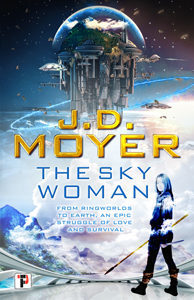 J.D. Moyer lives in Oakland, California, with his wife, daughter, and mystery-breed dog. He writes science fiction, produces electronic music in two groups (Jondi & Spesh and Momu), runs a record label (Loöq Records), blogs at jdmoyer.com, and tweets from @johndavidmoyer. His stories have appeared in F&SF, Strange Horizons, IGMS, and Compelling Science Fiction. His debut science fiction novel The Sky Woman was recently published on Flame Tree Press.
J.D. Moyer lives in Oakland, California, with his wife, daughter, and mystery-breed dog. He writes science fiction, produces electronic music in two groups (Jondi & Spesh and Momu), runs a record label (Loöq Records), blogs at jdmoyer.com, and tweets from @johndavidmoyer. His stories have appeared in F&SF, Strange Horizons, IGMS, and Compelling Science Fiction. His debut science fiction novel The Sky Woman was recently published on Flame Tree Press.
Want to take a writing class but don’t have the time or travel money? Check out the Rambo Academy for Wayward Writers, which offers live and on-demand writing classes aimed at fantasy and science fiction writers.
December 7, 2018
Alas Poor Ginger, Wherefore Art Thou: Trader Joe’s Dark Chocolate Covered Ginger
 I’m very fond of crystallized ginger, and accordingly I am substantially less fond of the Trader Joe’s Dark Chocolate Covered Ginger, whose ginger to “rich dark chocolate” ratio is weighted in chocolate’s favor to the point that the ginger is nigh imperceptible.
I’m very fond of crystallized ginger, and accordingly I am substantially less fond of the Trader Joe’s Dark Chocolate Covered Ginger, whose ginger to “rich dark chocolate” ratio is weighted in chocolate’s favor to the point that the ginger is nigh imperceptible.
The ingredients promise Australian crystalized ginger, and I do appreciate that Trader Joe’s, the J. Peterman of foodstuffs, has resisted the urge to embroider the tale with “harvested by koalas” or a story about backpacking across the outback while noshing on these or anything of that nature. But what’s given us instead of tasty, delicious ginger is waxy and overly sweet dark chocolate that is unappealing and which hosts a poverty of taste that is far from the promised richness.
The label makes no mention of fair trade or ethically sourced chocolate, which is honest, at least, and not the sort of “3% of our cacao beans are ethically sourced” shenanigans that some companies engage in. The smallish bag holds eight servings of what they claim is a 1/4 cup each, but these are apparently servings where the bits of chocolate repel each other, thereby taking up twice as much space in a measuring cup than normal.
All in all, a disappointing snack best suited to eating 3 am in an international airport, killing a few hours at a deserted gate while waiting for a lengthy flight, already sunk in ennui and listening to the echoes of the janitor’s footsteps as they mop a nearby lobby.
You can read this story at http://thegreenmanreview.com/food-and-drink/alas-poor-ginger-wherefore-art-thou-trader-joes-dark-chocolate-covered-ginger/


